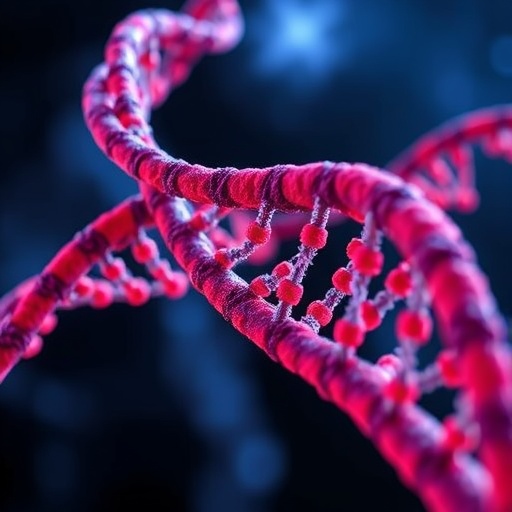In a groundbreaking development poised to redefine targeted cancer therapies, a team of researchers has identified a novel minor-groove DNA binder that exerts potent anti-tumor activity by repressing mitochondrial gene expression and triggering apoptosis in highly aggressive leiomyosarcoma cells. This discovery provides a fresh perspective on exploiting the mitochondrial genome as a therapeutic target, a frontier that has remained largely uncharted until now. The implications of this finding extend beyond sarcomas, potentially opening new avenues for precision oncology against a spectrum of malignancies characterized by mitochondrial dysfunction.
Leiomyosarcoma, a subtype of soft tissue sarcoma notorious for its aggressive phenotype and resistance to conventional therapies, has long presented a formidable challenge to clinicians. Researchers have struggled to develop effective treatments for these tumors because of their complex molecular landscape and adaptive resistance mechanisms. The identification of a novel compound that can directly bind to mitochondrial DNA and disrupt its expression heralds a paradigm shift in how this intractable disease might be combated at the cellular level.
The team, led by Malavasi, Picco, and Mallavarapu, embarked on this study with the goal of developing a compound capable of selectively targeting the mitochondrial minor groove DNA — a niche often overlooked by traditional DNA-binding drugs. Minor-groove binders typically interact with the DNA helix in a sequence-specific manner, influencing gene expression. However, as the mitochondrial genome is distinct and encased within the organelle, targeting it requires molecules with unique physicochemical properties to permeate mitochondrial membranes and exert localized action without compromising nuclear DNA integrity.
This newly identified minor-groove DNA binder exhibits a high affinity for mitochondrial DNA sequences crucial to the expression of genes involved in oxidative phosphorylation. By binding to these sites, it effectively suppresses mitochondrial transcription, leading to a profound disruption in mitochondrial bioenergetics. The inhibition of mitochondrial gene expression culminates in the collapse of mitochondrial membrane potential, a critical event that precipitates cellular apoptosis specifically in tumor cells reliant on mitochondrial function for survival.
Traditional chemotherapeutics often induce apoptosis through nuclear DNA damage, which can provoke deleterious side effects due to lack of specificity. In contrast, this novel agent’s ability to induce apoptosis via mitochondrial gene repression offers a level of precision hitherto unseen. This specificity not only minimizes collateral damage to healthy cells but also targets a vital vulnerability of cancer cells that exploit mitochondrial metabolism to fuel their rapid proliferation and resistance.
Enabling this breakthrough was the discovery that leiomyosarcoma cells are particularly dependent on mitochondrial gene expression for their survival and proliferation. Unlike many other tumor types, these cells exhibit heightened mitochondrial bioenergetic activity, making them uniquely susceptible to disruptions in mitochondrial DNA transcription. This vulnerability was exploited by the minor-groove binder, whose selective targeting induced apoptosis exclusively in cancer cells, sparing normal tissues.
Beyond the biochemical interactions, the research team employed cutting-edge imaging and molecular biology techniques to confirm the intracellular localization of the compound within mitochondria. Fluorescent tagging and advanced microscopy allowed for the visualization of drug accumulation within the organelle, solidifying the mechanistic understanding of its mode of action. Concurrently, gene expression profiling revealed a significant downregulation of mitochondrial genes post-treatment without affecting nuclear-encoded genes, underscoring the compound’s selectivity.
Moreover, the study reports that the novel binder achieves its therapeutic effect by disrupting the mitochondrial transcription machinery’s access to DNA, thereby causing a marked reduction in essential mitochondrial RNAs. This repression cascades into a breakdown of the electron transport chain components’ expression, drastically impairing ATP production. The energy crisis induced in the tumor cells triggers intrinsic apoptotic pathways, a process elegantly validated through caspase activation assays.
Importantly, the therapeutic window of this DNA binder has been characterized through extensive in vitro and in vivo studies. Normal cells exhibit robust resistance to this compound, highlighting a differential vulnerability that could minimize off-target effects. Animal models bearing leiomyosarcoma xenografts demonstrated significant tumor regression without observable systemic toxicity, a promising indication for translational potential.
The implications of this research extend to the broader field of mitochondrial biology in cancer. The mitochondria’s role as a key regulator of cellular fate decisions — through bioenergetic and apoptotic pathways — underscores the value of targeting mitochondrial DNA as a therapeutic strategy. This study elegantly bridges the gap between basic mitochondrial genetics and clinical oncology, proposing a targeted modality that bypasses traditional nuclear DNA damage mechanisms.
Furthermore, this novel approach challenges the prevailing dogma that mitochondrial genomes are less druggable due to their compact size and unique histone-free structure. By designing a compound capable of engaging mitochondrial minor grooves, the researchers offer a blueprint for future development of mitochondrial gene expression modulators. The findings provoke reconsideration of mitochondrial DNA as a ‘therapeutic genome’ that may harbor untapped molecular targets for oncologic intervention.
The technology utilized to identify and validate the minor-groove DNA binder involved sophisticated high-throughput screening and structure-guided drug design methodologies. Computational modeling allowed the team to predict binding affinities and tailor molecular configurations enhancing mitochondrial entry and DNA interaction specificity. Such an integrative approach underscores how interdisciplinary strategies are essential to tackle complex biological challenges in cancer research today.
Looking ahead, the researchers envision expanding their molecular library to discover additional minor groove binders that modulate mitochondrial functions differently, potentially overcoming resistance mechanisms. Moreover, combining this agent with established chemotherapeutics or mitochondrial metabolism inhibitors could synergistically amplify anti-tumor efficacy, offering hope for patients grappling with refractory sarcomas.
In the sphere of therapeutic development, a critical next step is the initiation of early-phase clinical trials. These will ascertain the safety, dosing parameters, and pharmacodynamics of the compound in human subjects, focusing initially on patients with metastatic or unresectable leiomyosarcoma. The precision and specificity demonstrated in preclinical work augur well for clinical translational success, highlighting a promising new weapon in the oncologist’s arsenal.
This discovery also spotlights mitochondria’s emerging role as a key regulator not only of apoptosis but of tumor metabolism and microenvironmental interactions. The prospect of manipulating mitochondrial gene expression to activate apoptotic cascades represents a formidable strategy capable of circumventing common modes of cancer cell survival adaptation.
In conclusion, the identification of this novel minor-groove DNA binder marks a seminal advancement in targeted cancer therapeutics. By repressing mitochondrial gene expression and inducing mitochondrial-dependent apoptosis specifically in leiomyosarcoma cells, the compound offers a refined therapeutic approach that harnesses mitochondrial vulnerabilities intrinsic to aggressive tumors. This pioneering research paves the way for innovative treatments that could extend survival and improve quality of life for patients challenged by currently incurable soft tissue sarcomas.
As this research progresses toward clinical application, the oncology community eagerly anticipates confirmation of these findings in patient populations, potentially transforming therapeutic strategies against mitochondrial-dependent cancers. The convergence of mitochondrial biology and drug design exemplified in this study may well herald a new epoch in precision medicine, redefining how we confront the molecular intricacies of cancer.
Subject of Research: Identification and characterization of a novel minor-groove DNA binder that represses mitochondrial gene expression and induces apoptosis in highly aggressive leiomyosarcoma cells.
Article Title: Identification of a novel minor-groove DNA binder that represses mitochondrial gene expression and induces apoptosis in highly aggressive leiomyosarcoma cells.
Article References:
Malavasi, E., Picco, R., Mallavarapu, S. et al. Identification of a novel minor-groove DNA binder that represses mitochondrial gene expression and induces apoptosis in highly aggressive leiomyosarcoma cells. Cell Death Discov. 11, 524 (2025). https://doi.org/10.1038/s41420-025-02803-3
Image Credits: AI Generated
DOI: 10 November 2025
Tags: adaptive resistance mechanismsanti-tumor activity discoveryapoptosis in cancer cellscancer drug developmentleiomyosarcoma treatmentmitochondrial DNA targetingmitochondrial dysfunction in tumorsmitochondrial gene expressionnovel DNA binderprecision oncology advancementssoft tissue sarcoma challengestargeted cancer therapies





